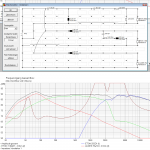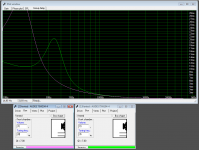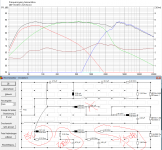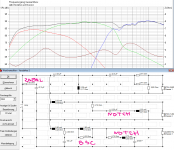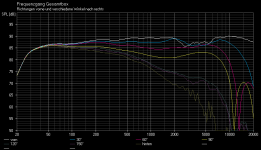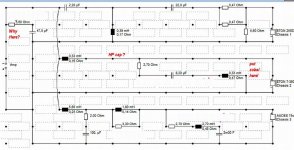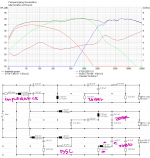tinitus said:... 27mh, thats a big one...
You can say that again, we're talking 3-4 kilos in pure cupper weight if it's cored correctly just to get the resistance to a reasonable low level. The 1.76 ohm is far from reasonable.
adason : I thougt with bass and mid in the same volume mid has more volume than when seperated and so there less trouble with reflected backwards sound coming through the driver again. Another advantage could be that both units have more volume. The mid is not a passive radiator because it is controlled by the amplifier and because most of the time people listen at low listeningvolume I thought the interaction between bass and middriver should not be a problem. But I'm not an expert...
Note : the speakers will be in a sideroom which means off axis listening so I designed a slightly rising frequencycurve on axis which means flatter off axis curve.
tinitus : thanks for point of xmax woofer I will look at that in WinISD Beta.
I haven't calculated listeningheight but I think/expect BOXSIM calculates this curve on listeningheight.
What would the use be of a cop in series with mid, I would lose bass and perhaps impedance would rise a little.
wakibaki : Active? My Orions are active LM4780 but I'm not an electrician, not again! My parents do not have budget for this and it's to difficult for me I suppose. What's more green 6 instead of 2 amps takes more energy when not listening plus the XO, electronics are often still active when music stopped. Really green is often a complex story.
petemck : I still don't see why I shouldn't put mid and woofer in same volume aren't there any advantages in one big volume?
tinitus : all components where 'calculated' by seeing the effect on the freq-curve in BOXSIM. I can try taking away the 27mH. The 400uF cap on the basswoofer can be an electrolytic I thought and should not be expensive.
I need some time working on the XO.
Note : the speakers will be in a sideroom which means off axis listening so I designed a slightly rising frequencycurve on axis which means flatter off axis curve.
tinitus : thanks for point of xmax woofer I will look at that in WinISD Beta.
I haven't calculated listeningheight but I think/expect BOXSIM calculates this curve on listeningheight.
What would the use be of a cop in series with mid, I would lose bass and perhaps impedance would rise a little.
wakibaki : Active? My Orions are active LM4780 but I'm not an electrician, not again! My parents do not have budget for this and it's to difficult for me I suppose. What's more green 6 instead of 2 amps takes more energy when not listening plus the XO, electronics are often still active when music stopped. Really green is often a complex story.
petemck : I still don't see why I shouldn't put mid and woofer in same volume aren't there any advantages in one big volume?
tinitus : all components where 'calculated' by seeing the effect on the freq-curve in BOXSIM. I can try taking away the 27mH. The 400uF cap on the basswoofer can be an electrolytic I thought and should not be expensive.
I need some time working on the XO.
Just kidding really, I don't really expect to drag you off course at this stage, although I reckon your protests about not being an electrician are false modesty.
Obviously you have other considerations such as integrating with existing equipment.
I do tend to think of systems like this as a bit anachronistic tho'.
w
Obviously you have other considerations such as integrating with existing equipment.
I do tend to think of systems like this as a bit anachronistic tho'.
w
Well, there's one way to do it here:
http://www.fortunecity.com/rivendell/xentar/1179/theory/dddllqd/dddllqd.html
IMO, I think you have more control using separate volumes, specially if you're covering different parts of the spectrum..
I'm not keen on the woofer adding extra vibes to the cone of the mid.
re: 'both units have more volume' - no, they don't, they share it proportionately, the calcs in the link above shows how it works
http://www.fortunecity.com/rivendell/xentar/1179/theory/dddllqd/dddllqd.html
IMO, I think you have more control using separate volumes, specially if you're covering different parts of the spectrum..
I'm not keen on the woofer adding extra vibes to the cone of the mid.
re: 'both units have more volume' - no, they don't, they share it proportionately, the calcs in the link above shows how it works
architect said:adason : I thougt with bass and mid in the same volume mid has more volume than when seperated and so there less trouble with reflected backwards sound coming through the driver again. Another advantage could be that both units have more volume. The mid is not a passive radiator because it is controlled by the amplifier and because most of the time people listen at low listeningvolume I thought the interaction between bass and middriver should not be a problem.
But I'm not an expert...
Hi,
You are correct in most respects as you have no high pass filter
on your upper bass/ midrange, in the bass it becomes a tandem
system. How different drivers interact in this case is not well
known though I'm sure it can be mathematically worked out.
Generally though a midrange has a high pass filter and this will
turn it into a passive radiator at low frequencies, your speaker
is a variant of a 2.5way not a 3-way due to lack of this filter.
I do not know what modelling your using but BSC seems missing.
🙂/sreten.
http://www.rjbaudio.com/Audiofiles/FRDtools.html
http://www.geocities.com/woove99/Spkrbldg/DesigningXO.htm
http://www.zaphaudio.com/
http://www.rjbaudio.com/projects.html
http://www.geocities.com/woove99/Spkrbldg/
http://www.troelsgravesen.dk/Diy_Loudspeaker_Projects.htm
http://htguide.com/forum/forumdisplay.php4?f=39
http://www.humblehomemadehifi.com/
http://www.linkwitzlab.com/
http://www.geocities.com/kreskovs/John1.html
http://www.musicanddesign.com/
Oke
1.
35Hz instead of 20Hz
In Unibox i found : Xmax is oke at 40W but at 130W excursion is too big, but I guess 40W is enough for my parents.
2.
separate closed enclosure for mid 10liters
means a little less bass output
3.
seperate bass reflex enclosure for woofer 70liters instead of 80liters is oke; it means a little less bass output
4.
removed the 27mH/cap/resistor but now I get a little bump around 80Hz
5.
BSC? baffles step compensation / correction
Is this a good solution, I understand this BSC as compensating for the loss of low frequencies because of it's less directive nature. But my parents will listen mostly off axis, so I would think I better compensate for loss of high frequencies.
1.
35Hz instead of 20Hz
In Unibox i found : Xmax is oke at 40W but at 130W excursion is too big, but I guess 40W is enough for my parents.
2.
separate closed enclosure for mid 10liters
means a little less bass output
3.
seperate bass reflex enclosure for woofer 70liters instead of 80liters is oke; it means a little less bass output
4.
removed the 27mH/cap/resistor but now I get a little bump around 80Hz
5.
BSC? baffles step compensation / correction
Is this a good solution, I understand this BSC as compensating for the loss of low frequencies because of it's less directive nature. But my parents will listen mostly off axis, so I would think I better compensate for loss of high frequencies.
Attachments
GD is mainly important in the music frequencies, in which the low tuned system is clearly superior
but don't just focus on GD....
but don't just focus on GD....
architect said:Oke
4.
removed the 27mH/cap/resistor but now I get a little bump around 80Hz
5.
BSC? baffles step compensation / correction
But my parents will listen mostly off axis, so I would think I better compensate for loss of high frequencies.
4. Could indicate a bit too small box, otherwise it looks ok, but maybe woofer series coil could be smaller, and maybe with a smallish paralel cap(maybe connected to ground with resistor=RC)
You may need a series cap on midrange...and a paralel RC
Maybe play a bit with series inductor
Tweeter series cap may be just a bit too small, try 5.6uf(standard value)
Paralel 0.39mH could be too big
Try smaller connect with a resistor to ground
5. NO...on the contrary...a well adjusted design sound the same almost everywhere, it doesnt change character...it may boom too much in some places, whish is much worse
btw, my rule is to always stick to standard values
Re: improved XO
how about building one yourself? in that case I would suggest a Hypex class D, a very good sounding amp, which has no problems at all with the low impedancearchitect said:.... impedance is about 2 ohm, is this problematic. my dad also needs another amp, any advice on what to look at?
Re: improved XO
Simple L-pad on woofer is not going so well
architect said:
at lowest frequencies impedance is about 2 ohm, is this problematic.
crossover any advices?
Simple L-pad on woofer is not going so well

Woofer xo is the other way round...big inductor first
Preferably only one zobel
1.21mH with 3.1ohm could be used good though...try to connect a cap after 3.2ohm...which means in series with resistor and both paralel across inductor
Midrange
Still think it needs a small zobel...like say about 8.2uf - 8.2ohm
Looks like you need to raise xo point about 500hz
Tweeter
Try make 30uf smaller
Attenuation wrong...series resistor always small and the paralel big
It may not show on sim, but you will like a zobel on tweeter too
As said it seems you have reversed mounting on curcuits and components
Fore one I always have resistor to ground
And biggest component in a curcuit first
Again, I strongly advise to caculate with standard values
Preferably only one zobel
1.21mH with 3.1ohm could be used good though...try to connect a cap after 3.2ohm...which means in series with resistor and both paralel across inductor
Midrange
Still think it needs a small zobel...like say about 8.2uf - 8.2ohm
Looks like you need to raise xo point about 500hz
Tweeter
Try make 30uf smaller
Attenuation wrong...series resistor always small and the paralel big
It may not show on sim, but you will like a zobel on tweeter too
As said it seems you have reversed mounting on curcuits and components
Fore one I always have resistor to ground
And biggest component in a curcuit first
Again, I strongly advise to caculate with standard values
I said "biggest" components first...I referred to woofer xo, lowpass
Highpass is the opposite..."small" components first
Sometimes I get them mixed up
btw, theres a lot to learn from looking at a crossover like this...Troels seems to change his style a bit, and using the special notchlike filter...he may use it as the sole curcuit on a driver, and must like it a lot, as he seems to use it in every new design
I have used that special "notch" fore quite some time now, but solely on woofers and only as a supplement, but maybe one should consider to use it in other places as well as it seems to work/sound very well
http://www.troelsgravesen.dk/cyclop.htm
Highpass is the opposite..."small" components first
Sometimes I get them mixed up

btw, theres a lot to learn from looking at a crossover like this...Troels seems to change his style a bit, and using the special notchlike filter...he may use it as the sole curcuit on a driver, and must like it a lot, as he seems to use it in every new design
I have used that special "notch" fore quite some time now, but solely on woofers and only as a supplement, but maybe one should consider to use it in other places as well as it seems to work/sound very well
http://www.troelsgravesen.dk/cyclop.htm
some remarks on the filter:
- I see the mid is left unfiltered at the bass end, which is the cause of the <2ohm impedance in the bass. if the amp can handle it, OK it might sound good, but you could consider a HP condensator there (might also influence the filtering of the bass)
- you have only a single coil for the mid, and no zobel to compensate for the rising impedance, which renders the filtering ineffective towards the higher frequencies. i suggest you put a zobel there
- what's the use of the zobel in the tweeter network? and it seems to me in a strange location...
- I see the mid is left unfiltered at the bass end, which is the cause of the <2ohm impedance in the bass. if the amp can handle it, OK it might sound good, but you could consider a HP condensator there (might also influence the filtering of the bass)
- you have only a single coil for the mid, and no zobel to compensate for the rising impedance, which renders the filtering ineffective towards the higher frequencies. i suggest you put a zobel there
- what's the use of the zobel in the tweeter network? and it seems to me in a strange location...
Attachments
Henkjan said:some remarks on the filter:
- I see the mid is left unfiltered at the bass end, which is the cause of the <2ohm impedance in the bass. if the amp can handle it, OK it might sound good, but you could consider a HP condensator there (might also influence the filtering of the bass)
- you have only a single coil for the mid, and no zobel to compensate for the rising impedance, which renders the filtering ineffective towards the higher frequencies. i suggest you put a zobel there
- what's the use of the zobel in the tweeter network? and it seems to me in a strange location...

Further, best get rit of woofer notch
Instead try a cap on 1.8mh/3.3ohm...in series with and after 3.3ohm, both still in paralel with 1.8mH
Try 8.2-12uf...3.3ohm is probably too small, try 8.2-15ohm
Woofer zobel...smaller cap and bigger resistor
Paralel curcuits...as said before, I have the resistor connected to ground, but cant say if it makes a difference
Zobel on input before xo...not sure its a good idea
Oke another improved filter.
Henkjan, what kind of cap sould you advise on the mid? when I try 100uF The curve is very ugly with a kind of bump at 75dB; not a nice fluid curve. I thought it would be a good idea not to use bipolar caps on the mid so if I'm right 100uF is about the max. When I add an inductor after the cap and parallel to the mid I need to change poles on the woofer and mid and tweeter should be attenuate to match the basswoofer. I'd like some advise on this point. But you are right, impedance at lowest frequencies gets better.
zobel on mid added
zobel removed but zobel and impedancecorrection for tweeter added; both seems to be effective
notch on woofer not removed, helps to keep bump out of responsecurve, I changed some values to improve impedance.
I tried the suggestion of parallel cap and larger resistor on woofer but this seems not to make the curve any better. I changed them backwards to old values. (not yet in added picture)
zobel for woofer also straightens off axis responsecurve
resistors have been put at ground-side
Henkjan, what kind of cap sould you advise on the mid? when I try 100uF The curve is very ugly with a kind of bump at 75dB; not a nice fluid curve. I thought it would be a good idea not to use bipolar caps on the mid so if I'm right 100uF is about the max. When I add an inductor after the cap and parallel to the mid I need to change poles on the woofer and mid and tweeter should be attenuate to match the basswoofer. I'd like some advise on this point. But you are right, impedance at lowest frequencies gets better.
zobel on mid added
zobel removed but zobel and impedancecorrection for tweeter added; both seems to be effective
notch on woofer not removed, helps to keep bump out of responsecurve, I changed some values to improve impedance.
I tried the suggestion of parallel cap and larger resistor on woofer but this seems not to make the curve any better. I changed them backwards to old values. (not yet in added picture)
zobel for woofer also straightens off axis responsecurve
resistors have been put at ground-side
Attachments
- Status
- Not open for further replies.
- Home
- Loudspeakers
- Multi-Way
- 3 way for my dad
